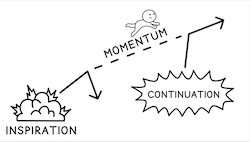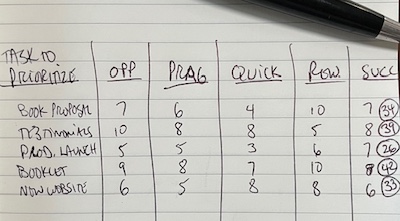|
"Efficiency is doing things right; effectiveness is doing the right things." – Peter Drucker

This week I got to dust off an old prioritization tool. I showed it to a group of managers facing a long list of competing priorities. At first blush this tool looks like more work than the list itself, but when used correctly, it helps us attack tasks feeling invigorated, in control, and confident of progress. The basic idea is when you have a long list of items that you need to accomplish, focus on what you think are the highest gain activities.
But they're all important, Greg.
I know, I know, this is yet one more "simple, but not easy" solution to a common problem from my trusty tool box.
This tool helps us tease out what we think is the highest gain activity. It focuses us on the potential outcome compared to the company's goals, and contrasts against effort. The tool lets us focus 1/3 of our energy on 2-3 activities that will get us to 80% of where we need to be.
How to start
The first step is to list all tasks/events competing for your attention. Using freewriting and concentrated effort, give it 20 minutes of uninterrupted thought.
The second step is to use a single set of criteria to score the list of items against each other. An easy one is OPQRS: Opportunity, Pragmatic, Quick, Rewarding, and Success. Quick definitions.
Opportunity is scoring the capability to do the task. Use a scale of 1-10. If you have all the tools needed at your disposal, give it an 8 or 9 or 10. If you're missing key pieces, give it a 2, 3 or 4. (It's common to end up with most lumped into the 6 or 7 range.)
Pragmatic is scoring how realistic the priority is to actually work. "Should work" or "it worked for others" is a low score. "Been there done that" is a 7, 8, or 9.
Quick is scoring how quickly the results will show up. Faster is a higher score.
Rewarding is scoring how personally rewarding you or your team will find the task. It’s not uncommon to score a priority low on the Opportunity rank, but high in Rewarding. (FIT says we're more likely to do tasks we find rewarding)
Success is scoring how likely the task is to get the results you need. The success score sits apart from the other four because gut feel shows up here. If you have a gut feel it's going to be important, score it high. If you're not sure, score low.
Work the grid
The temptation is to work each task across the grid. Instead, work each column/criteria at once. This let's you score the tasks against one another, leading to a better result. After scoring each task, add up the columns and consider the scores. Your grid should roughly look like this:

I pick a short list of marketing tactics for my example. The scoring of tasks against each other makes the exercise go fast. In my example, the tasks that rise to the top are a new booklet, testimonials, and a book proposal. A mix of things I find rewarding/easy to do, and something I don't like to do, but I know will get me closer to my goal (asking for testimonials).
In roughly 30 minutes, the managers have a guide they can use to prioritize their focus for the next 30 days. It lets them use their strengths, it gets activity started, and it builds momentum.
Good stuff.
|